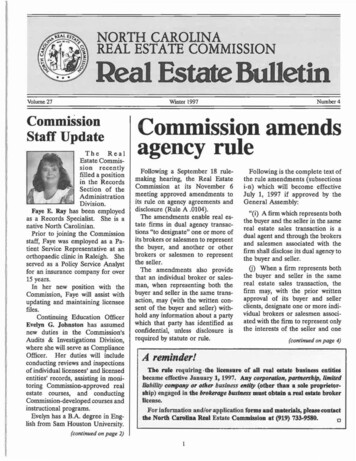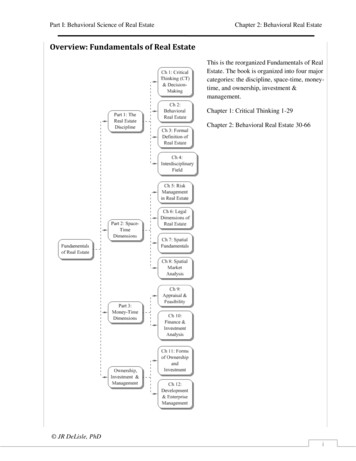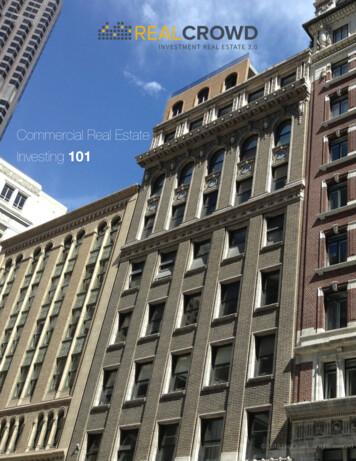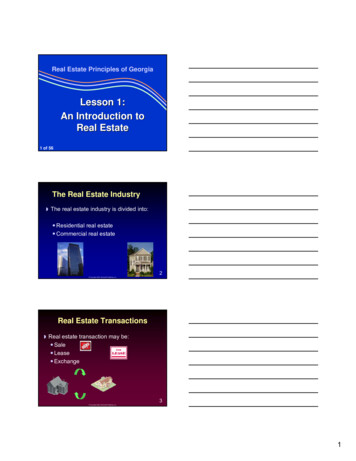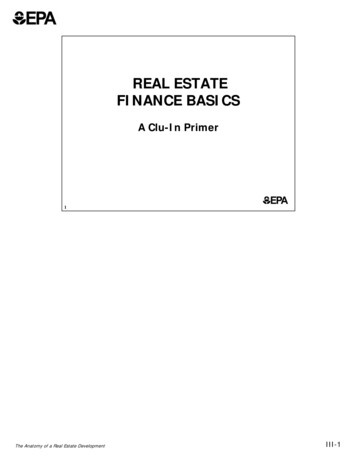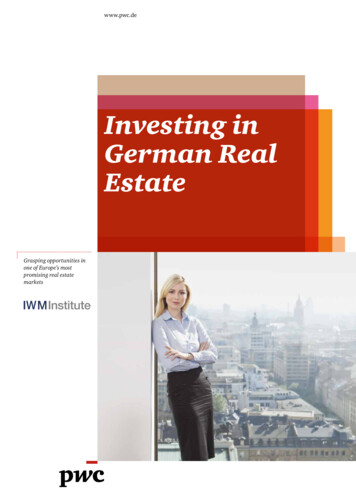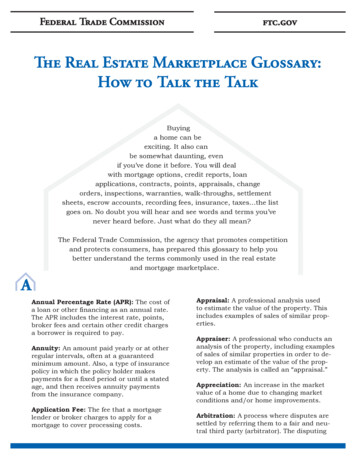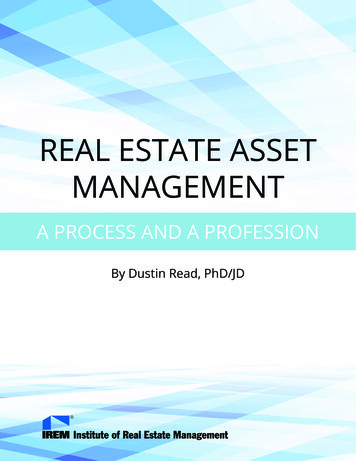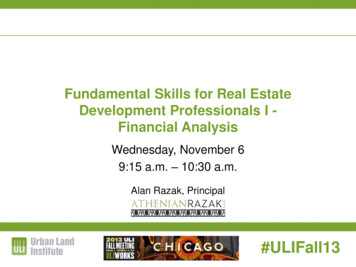
Transcription
Fundamental Skills for Real EstateDevelopment Professionals I Financial AnalysisWednesday, November 69:15 a.m. – 10:30 a.m.Alan Razak, Principal#ULIFall13
Development ProcessTASKQ3 03Q4 03Q1 04Q2 04Q3 04Q4 05Q1 06Q2 06Q3 06Q4 06DESIGN TEAM ASSEMBLYSITE EVALUATIONMARKET ANALYSISBUDGETING & SCHEDULINGLEGAL & ADMINISTRATIVE SET-UPMASTER PLANNINGLAND USE APPROVALSFINANCINGDESIGN/CONSTRUCTION DOCSVALUE ENGINEERINGBUILDING PERMITSCONTRACTINGCONSTRUCTIONPROJECT CLOSE-OUTSALES & MARKETINGApprovalsDesignConstructionPhase IV - Post-ConstructionPost-ConstructionSales Sales#ULIFall13
ULI Education ProgramsIn-Person ProgramsReal Estate Development Process: Part IReal Estate Development Process: Part IIBasic Real Estate FinanceReal Estate Finance IReal Estate Finance IIBasic Pro forma Modeling Using ExcelFundamentals of Land Development: Tools and StrategiesConstruction Fundamentals for Development ProfessionalsAdvanced Pro Forma Modeling Using ExcelMultifamily Housing Development and InvestmentPrivate Equity Capital: Understanding and Navigating the OptionsMixed Use for the New Economy: ULI Study TourAdvanced Real Estate Finance: Capital Sources and Deal StructuresValue-Add Real Estate Development and Investment (Real Estate Entrepreneur Series)Structuring Your First Real Estate Deal (Real Estate Entrepreneur Series)Executive Small Scale Developers Workshop (Real Estate Entrepreneur Series)#ULIFall13
ULI Education ProgramsOnline ProgramsCreating an Effective Investment Proposal Template21st Century Real Estate Portfolio ManagementCreating Reliable Valuations for Distressed AssetsBasics of Real Estate FinanceEvaluating Project Viability Using Internal Rate of Return (IRR) and other Financial MetricsExcel Tips and Shortcuts for Real Estate ProfessionalsHotel Pro forma Development for the BeginnerIntroduction to Modeling Investment Waterfall DistributionsIntroduction to Pro forma Modeling with ExcelPro forma Modeling a Single-Family Home CommunityPro forma Modeling with Excel: Part IIUnderstanding and Navigating the World of Real Estate Private EquityUnderstanding and Utilizing the Time Value of Money (TVM) ConceptUnderstanding Commercial Cap RatesUnderwriting Office and Multifamily Real Estate InvestmentsThe ABCs of Land DevelopmentPublic-Private Partnerships Today: Tools, Tactics, and OpportunitiesUsing Public-Private Partnerships to Create Value-Added ConversionsDetermining Project Viability: Residual Land Valuation and Predevelopment Task ManagementManaging Successful Entitlements: Building Community and Political Support for Land Use Projects#ULIFall13
ULI Education Programs For more information– www.uli.org/programs/education– Or contact Dave Mulvihill at:David.Mulvihill@ULI.org#ULIFall13
Real Estate Development WorkshopFundamental Skills for Real Estate Development Professionals IFinancial Analysis9:15-10:30Alan RazakPrincipal, AthenianRazak LLCSite Selection and Due Diligence10:45-12:00 Charles A. LongPresident, Charles A. Long PropertiesFundamental Skills for Real Estate Development Professionals IIProject Entitlement1:15-2:30David H. Farmer, PE, AICP, CGCManaging PrincipalKeystone Development AdvisorsStructuring the Deal to be Profitable3:00-4:15Christopher StromDirector of Project DevelopmentAthenianRazak LLC#ULIFall13
Basic Finance Concepts Financing Phases & TypesEvaluation ToolsTime Value of MoneyRisk and Return on InvestmentInvestment Value#ULIFall13
Key Project Planning Questions Does the market need my project? Can I bear the cost of getting the project to the point ofconstruction?– Scheduled tasks and costs– Sources of funding for each task Will the project, if built, be profitable?– Overall profitability based on project value less projectcost– Amount of debt, amount of equity#ULIFall13
Project return is expressed many different ways Gross Rent MultiplierCash-on-cashReturn on sales (ROS)Return on costs (ROC)Return on equity (ROE)Net Present ValueInternal Rate of ReturnHurdle rate#ULIFall13
Financing Phases & Types Financing Phases– Predevelopment– Construction– Bridge/Mezzanine– Permanent Debt Equity#ULIFall13
Risk and Return on Investment What’s a reasonable return? Evaluation of Risk determines required return in relationto alternate investments What do you expect back from:– U.S. Government (T-Bills)– Bank (Demand Deposit)– Corporate Bond– Mutual Fund– Tech Stock– Your No-good Brother-in-Law#ULIFall13
Risk and Return on Investment Expected rate of return “Risk-Free” rate of return risk premium The difference between rates of return for differentinvestments reflects market adjustment for comparativeperceived risk Variables include– Safety of principal– Duration of investment– Timing of cash flows– Difficulty of execution#ULIFall13
Predevelopment Analysis Types Market Analysis: Is the project needed?– Determining market support for a proposedproject in the proposed location– Evaluates supply & demand– Estimates potential income Feasibility Analysis: Will the project work?– Adding financial evaluation to Market Analysis– Determines whether the proposed project canachieve the desired financial objectives– Considers production cost– Involves discounted cash flow analysis#ULIFall13
What is Value? Value of an Investment is measured by what you getback vs. what you put in Evaluated against all other potential uses for investmentfunds “What you put in” is not just cash In real estate development, what you put in is a list ofitems which are spread over time#ULIFall13
Methods of Calculating Value Appraisal Approaches– Income Approach– Comparables– Replacement Cost Investment Methods (variants of Income Approach)– “Single-number” Analyses Cash-On-Cash (Return on Equity) Income Capitalization using Capitalization Rate– Discounted Cash Flow Analysis Net Present Value (NPV) Internal Rate of Return (IRR)#ULIFall13
Sources of Return on Investment Definition of “What You Get Back” depends– on property type (sale vs. rent)– on valuation method Using Cash on Cash or Income Capitalization– Stabilized Net Operating Income Using Discounted Cash Flow– Periodic Cash Flow– Value Appreciation (realized at reversion)– Tax Shelter#ULIFall13
Single-number Analysis: NOI Uses a single number (e.g.; Net Operating Income for rentalproperties) as basis of value calculationOperating IncomeGross RentLess:Operating ExpensesUtilitiesReal Estate TaxesCleaningMaintenance & RepairsProperty ManagementInsuranceNet Operating Income Does not include income taxes, depreciation or debt service Equivalent to corporate EBITDA#ULIFall13
Cash-On-Cash (ROE) Measures the rate of return on equity only Most often used in for-sale projects but also benchmarksrental projectsCash Flow Before TaxesROE Total Equity Invested#ULIFall13
Capitalization Rate (Cap Rate) Measures the rate of return on total capital invested (i.e.,the estimated rate of return on a property at the time ofpurchase or initial stabilized year) Used in rental propertiesNOICap Rate Total Capital Invested#ULIFall13
What is Total Capital Invested?Total Development CostorTotal Purchase Price of the Propertyor(introducing the concept of deal structure)Equity (Investors) Debt (Lenders)#ULIFall13
Cap Rate vs. P/E Ratio Cap rate is the inverse of the P/E ratio used in the stockmarketCap rateP/E Ratio2%503%334%255%206%16.7#ULIFall13
Corporate Equities vs Real Estate ReturnsA high P/E (low cap rate) signals expectations of growth inincome.John DeereFord MotorBoeingMicrosoftAppleGeneral ElectricGoogleClass A CBD Office, 1995Class A CBD Office, 2007Class A CBD Office, 2012P/E Ratio9.611.512.713.113.118.429.612209.1 - 25.0Cap 4.0% - 11.0%#ULIFall13
Pop Quiz! What is the project value?Net Operating Income 3,000,000 3,000,000 3,600,000 5,000,000 2,500,000Cap Rate5%7.5%6%10%5%Value 60M 40M 60M 50M 50M#ULIFall13
Limitations of “Single Number” Value Calculations Cash-on-Cash and Income Capitalization Approacheshave significant limitations. What are they? They don’t consider potential fluctuations in cash flowsover time– Cash flows occur over time but they use only onefixed value as basis of income– Don’t allow for varying rates of growth of income andexpense components Their adjustment for risk is a blunt instrument Don’t fully consider effects of leverage Don’t consider value appreciation#ULIFall13
Time Value of Moneyreceived today received tomorrowWHY?#ULIFall13
Present Value Present Value is a short-form methodology used toevaluate a future cash payment or receipt, a function of– Future (face) value (FV)– Discount Rate (i)– Time (n periods)PV FV/(1 i) n Note: In this sense, the Cap Rate is a specialized discountrate - a real estate “term of art”– Rate of expected return, expressed as a percentage,indicating current market conditions for valuing a projectFinancial Analysis#ULIFall13
Present Value ExampleSingle payment received (FV)Your Discount Rate (i)Received 12/31/2016 (n periods) 10 million10%7.2 yearsPV FV/(1 i) nPV 10,000,000/(1 .10) 7.2PV 5 millionNote the Rule of 72!#ULIFall13
Discounted Cash Flow Analysis Measures the present value of the income stream tobe generated by the property over the life of theinvestment#ULIFall13
Discounted Cash Flow Analysis Discounted Cash Flow analysis is the only really validway to measure project return– Fully accounts for the time value of money– Allows for variable cash flows– Allows for differential growth rates of income andexpense components– Allows explicit & discrete inclusion of tax benefits andvalue appreciation (through reversionary value) Yields two key benchmarks– Net Present Value– Internal Rate of Return#ULIFall13
Net Present Value (NPV) The value (in terms of today’s dollars) of all future cashflows, positive and negative, from the project asdiscounted by the required rate of return (aka discount orhurdle rate), minus the cost of acquiring the property.Income for each periodPresent ValueInitial123@ i 12% investment( 100.00) ( 100.00) 5.36 6.00 5.58 7.00 5.69 8.00 69.91( 13.46) NPV (sum of all PV's)4 110.00#ULIFall13
Internal Rate of Return (IRR) The discount rate (stated as a percentage) at which thepresent worth of future cash flows is exactly equal to theinitial capital investment i.e.; rate of return where NPV 0Income for each periodPresent ValueInitial123@ i 7.63% investment( 100.00) ( 100.00) 5.57 6.00 6.04 7.00 6.42 8.00 81.97 0.00 NPV (sum of all PV's)4 110.00#ULIFall13
Capitalized Value: a back of the envelope approachShock & Awe450K GSF x .88 efficiencySizeRentMarket Rents DeveloperNOI 400,000 SF, 92.5%occupied@ 30/SF1 AnywhereStreetPalookaville, USA 10000Cap Rate 400,000 SF 30 NNN 11.1M / 7.5% 11,100,000/yr7.5% 148M#ULIFall13
Potential IncomeOperating IncomePer SFGross Rent 40.00Operating ExpensesUtilitiesReal Estate TaxesCleaningMaintenance & RepairsProperty ManagementInsuranceReplacement ReserveTotal Operating ExpensesNet Rent Rate 2.751.752.25.751.25.50.75 10.00 30.00#ULIFall13
Components of Cost25,000SF @ 18FAR 450KSF @ 25/FAR-FTLandHard Costs 450KSF @ 175/SFSoft costs10% of Hard CostsMktg/Comm’s 8% of lease values ( 12M NOI x 10 yrs x 8%)Financing/Carry 30 months @ 6.5%, 50% avg balance 1 ½ points One year carryContingency10% of non-land costs 11.3M 79M 8M 9.6M 15.3M 11M 134M#ULIFall13
So How do we pay for it?#ULIFall13
Basic Financing Structure Involving Debt and EquityDEBT SOURCE:LendersFUNDSCAPITALCONSTRUCTION ANDPERMANENT DEBT FINANCINGPUBLIC SECTORAGENCIESPUBLICPARTIC,TAXES &FEESEQUITY SOURCE:Owners andInvestorsPRE-DEVELOPMENT ANDPERMANENT EQUITY FINANCINGDEBT SERVICEENTITLEMENT,FUNDSFUNDSRETURNTHE REAL ESTATEVISION,SKILLS,PRE-DVMT,FUNDSPolitical / Physical / EconomicOpportunities & ConstraintsRETURNDEVELOPEROPERATORSALE, LEASE, COMMODITYORAND/OR VALUEOCCUPANCY THE MARKETUSERS#ULIFall13
The Capital StackEquityMezzanine orperforming debtDebt20% to 60% of project costsPays return based on performanceGap financing to cover costs not supportedby debt or equity.Usually paid through performance.40% to 80% of project costsPays interest, secured by lien#ULIFall13
Debt Annual interest of 4% to 6.5% hedged, 10 to 30 yearamortization. 5 to 10 year balloon payment. Loan amount a fraction of asset value Developer may be required to guarantee performancethrough recourse provisions:– Project completion– Cost estimates– Lease upUrban Land InstituteReal Estate Development Process II#ULIFall13
Lender’s Triangle Lenders fund a loan based on ratios and usually fund thelowest of the three.– Loan-to-Cost (LTC) Cost total project budget (hard & soft costs)– Loan-to-value (LTV) For a bank, as determined by appraisal– Debt-service Coverage Ratio (DCR) Ratio of Net Operating Income to Debt Service. Varies from 1.15 to 1.3#ULIFall13
Equity Total target return varies by sector. Preferred return 9%-12% Usually 15% to 25% "target" total annual return. Developer usually must co-invest about 10% of equity.#ULIFall13
Equity (continued) After debt, "profits" pay1. Return of principal2. A preferred return of 9% to 12%3. A promotional return to achieve target, with somereturn to developer.4. After target is reached, higher return to developer.#ULIFall13
More debt financing / More leverage Debt costs less than equity (why?) Higher leverage means higher returns on equity Return is expressed as– "leveraged" : return on equity– "unleveraged" : return on total costsUrban Land InstituteReal Estate Development Process II#ULIFall13
Target Returns: Each use is differentSectorTarget IRR*Timing of sale or leaseLand Development20-30%With phasingDepends on phaseFor-sale residential8-20%Pre-sales for each phaseNone7.5-11%Lease-up after constructionNoneOffice7-12%Pre-leasing desirableDesirableRetail7-12%Pre-leasing usually req’dDesirabl
Basics of Real Estate Finance Evaluating Project Viability Using Internal Rate of Return (IRR) and other Financial Metrics Excel Tips and Shortcuts for Real Estate Professionals Hotel Pro forma Development for the Beginner Introduction to Modeling Investment Waterfall Distributions Introduction to Pro forma Modeling with Excel Pro forma Modeling a Single-Family Home Community Pro forma .

